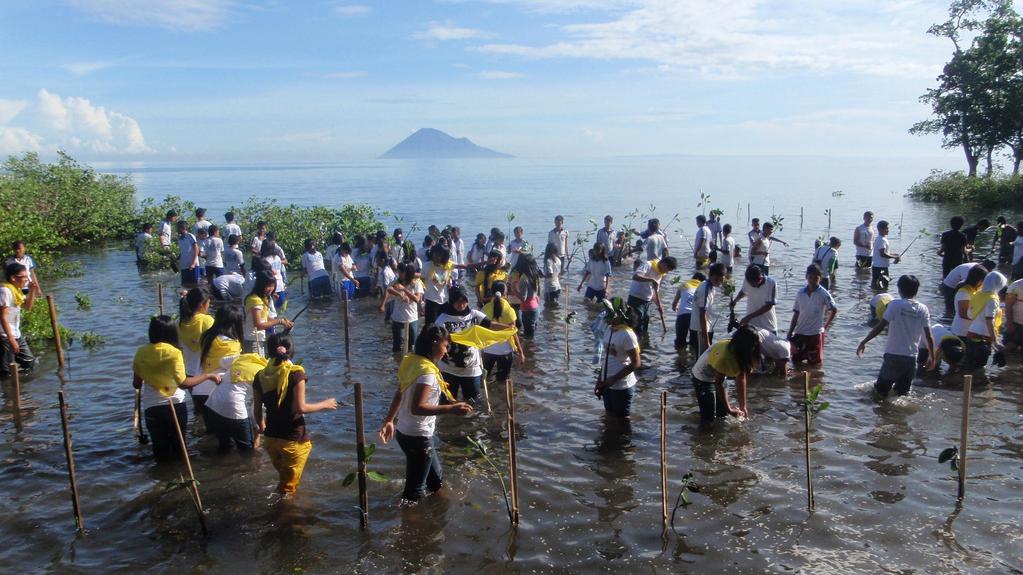Restoring mangroves in Indonesia
Local residents help replant mangrove trees on a degraded beach on the Indonesian island of Sulawesi. Tropical mangroves are vital for both fish habitat and protection from storms, but over the last few decades they’ve been disappearing around the world as coastal areas are developed for aquaculture and other businesses.
The Celebes Sea laps at a narrow, gravely beach on the northern arm of the Indonesian island of Sulawesi. Not long ago, this stretch of coastline in the village of Minahasa was thick with a web of mangrove trees.
And if the efforts of local residents are successful, it will be again.
Under the warming tropical sunshine, dozens of community members dig grapefruit–sized holes every few feet along the beach to prepare the way for mangrove seedlings. Others stand by to do the planting—local residents, government officials, and even the president of one of Indonesia’s largest banks.
Mangroves were once widespread throughout the world’s warm coastal areas. They’re a crucial ecosystem and a buffer against erosion, but over the last few decades, they’ve been disappearing around the globe.
Thirty years ago, the shores of Indonesia’s 17,000 islands boasted more than 42 million acres of mangroves. That’s an area the size of Wisconsin.
But by the 1990s, half the mangroves had been destroyed for firewood, charcoal and timber, and to clear the way for fish and shrimp farms.
But attitudes towards mangroves have started to change here.
15 year-old Susi Mashanafi is one of several hundred school children helping with the replanting. She’s got a warning for people who’d cut down mangroves.
“I think we must give them a hard punishment to them,” Mashanafi says. “Because it can be a big problem for us in our future if they’re cutting down the mangrove in the beach.”
When mangrove stands are destroyed, coastal areas become far more vulnerable to the ravages of the sea. A few years ago, Mashanafi and other Indonesians learned this the hard way.
“Tsunami, of course,” she says, referring to the massive 2004 tsunami that devastated parts of Indonesia. Entire communities were washed away, and over 240,000 Indonesians died.
But the huge wave also made it clear just how valuable intact mangroves are.
Janot Mendler de Suarez, a project coordinator with the Global Environment Facility, says the difference is clear from satellite photos.
“We can see from the satellite data that those communities where the mangroves were intact, where the coastal ecosystems had not been degraded, suffered much less damage,” Mendler says.
“(These areas) were protected. So we don’t need to do studies and wait to find out if this is going to work. We know it’s going to work.”
The Indonesian government seems to share that certainty. They’ve moved to safeguard mangroves throughout the country by designating a protected “green belt” along the coast. They’re promoting rehabilitation programs like the community planting in Minahasa, and encouraging the use of fast-growing trees instead of mangroves for firewood and charcoal.
The government’s also trying to raise awareness of the mangroves’ broader ecological and economic importance.
John Tasirin, a professor of ecology at Sam Ratulangi University, says mangroves provide vital habitat for fish and countless other animals.
“Therefore, (they) also support the life of the people in the coastal community, which is dependent on ocean also,” Tasirin says. “So almost 90% of the villagers along the coast of North Sulawesi here are proposing to plant the mangroves. They want to restore the mangroves, bring it back as what they see a long time ago.”
Some of the local restoration programs begin at the mangrove seedling plantation of Madgid Blongkot, in a village to the north.
Blongkot is a gentle man with leathery, sun-baked skin, who on a humid afternoon shows off a few hundred seedlings growing in little bags of earth under a thatched roof.
He started the plantation ten years ago on a former mangrove swamp that had been converted to shrimp farming and then abandoned.
Now, he says, “after rehabilitating the area… it can become the habitat of creatures such as birds and other things, and then it can increase the income of the people.”
Blongkot employs 15 people full-time, and sells about 600,000 mangrove seedlings a year, including the ones now growing on Minahasa’s gravely beach.
Nola Femmy Rondonuwu, the head of the watershed management office in Minahasa, says Blongkot and his group are a real success story. But he says other Indonesian communities still have a ways to go.
“Some of them are not well trained, some of them are not well educated and still don’t (understand) the importance of protecting (and) rehabilitating the area,” he says. “It’s a matter of human resource skill… and the awareness of the people living around that area.”
Some here say it’s also a matter of an even stronger government commitment. Their concerns include lax protection of the green belt, and inadequate monitoring of replanted areas.
But the government does seem serious about education. That’s one of the reasons so many schoolchildren came to the mangrove planting. There’s a national effort to teach students about the importance of conserving the environment, including mangroves.
Public high school number 5, in the nearby city of Manado, is part of that effort. Its classrooms encircle a sun-drenched courtyard, where I found sixteen-year-old Yoann Ayuwa, just getting out of biology class.
The conservation message is certainly grabbing her.
She says students need to start getting the message out to theirfamilies.
“And then we go onto the community, the society and the whole nation,” Ayuwa says, “so that people will realize that conserving and keeping the ecology is really an important thing for the future of our generation.”
